 |
LABOR TURNOVER AND LABOR EFFICIENCY RATIOS & FACTORY OVERHEAD COST |
| << PIECE RATE BASE PREMIUM PLANS:Suitability of Piece Rate System, GROUP BONUS SYSTEMS |
| ALLOCATION AND APPORTIONMENT OF FOH COST >> |
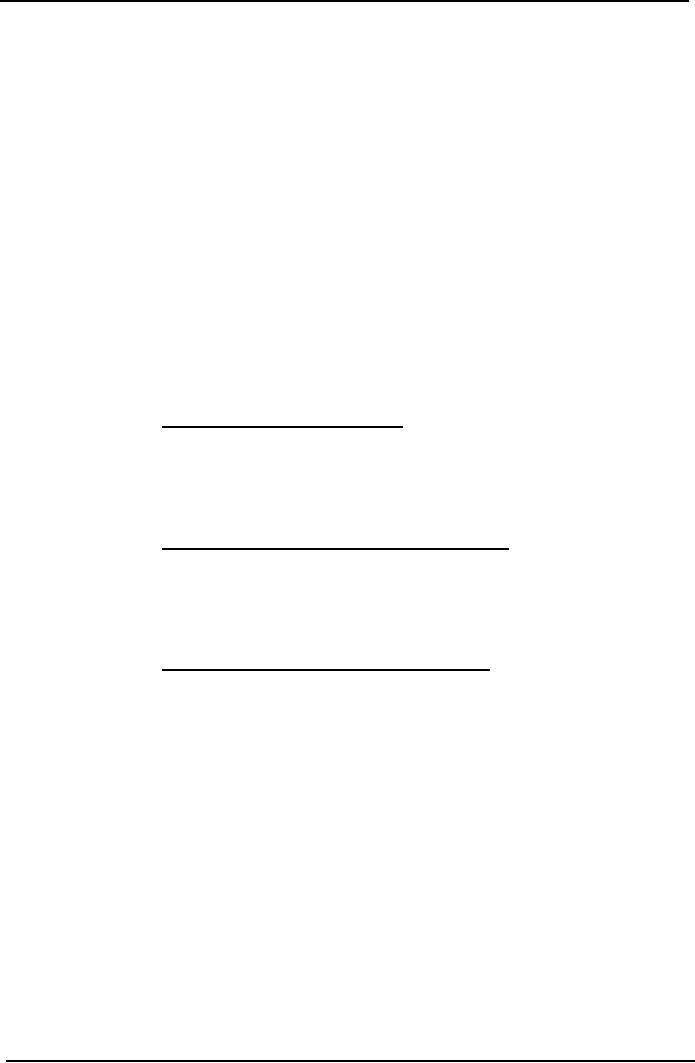
Cost
& Management Accounting
(MGT-402)
VU
LESSON
# 14
LABOR
TURNOVER AND LABOR EFFICIENCY
RATIOS
&
FACTORY OVERHEAD
COST
Labor
Turnover:
Labor
turnover may be defined as the
rate of change in the
composition of the labor
force of an
organisation
high rate of labor turnover
denotes that labor is not
stable and there is
frequent
change
in the labor force in the
organisation. The high labor
turnover rate is an
important
indication
of high labor cost. It is
therefore not
desirable.
Measurement
of Labor Turnover:
There
are various methods for the
measurement of labor turnover.
The choice of method
of
measurement
would depend on the organisation.
But, however, once a
particular method is
adop-
ted
for it, it should be
followed for quite some
times, so that a clear and
comparative picture is
obtained.
The methods of measurement
are:
(1)
Separation method;
Labor
turnover is measured by dividing
the total number of
separations (workers
left
the
organisation) during a period by the
average number of workers on
the pay roll.
Labor
turnover
Number
of separations in a period x 100 Average
number of
workers
in a period
(2)
Flux method:
Labor
turnover is measured by dividing
the total number of
separations and
replacements
by the average number of
workers.
Labor
turnover
Number
of separations + number of replacement x
100 Average number
of
workers during the
period.
(3)
Replacement method:
Labor
turnover is measured by dividing
the number of replacements
during a
period
by the average number of
workers employed in that period.
Labor
turnover
Number
of workers replaced during
the period
Average
number of workers during the
period.
Average
workers employed = Number of workers at
the beginning of the period + Number
of
workers
at the end of that period divided by
2.
PRACTICE
QUESTION
The
personnel department of a company has
supplied the following information
relating to its
work
force during the month of
June, 2006.
Number
of workers:
1st.
June
1900
th
30
. June
2100
During
the month 60 persons were
discharged and 20 left the
company. During the month
200
workers
were engaged out of which
only 40 workers were appointed
against the vacancy caused
by
the
number of workers separated
and the remaining on account of an
expansion scheme of the
company.
Calculate
labor turnover rate and
equivalent rate under
different methods.
99
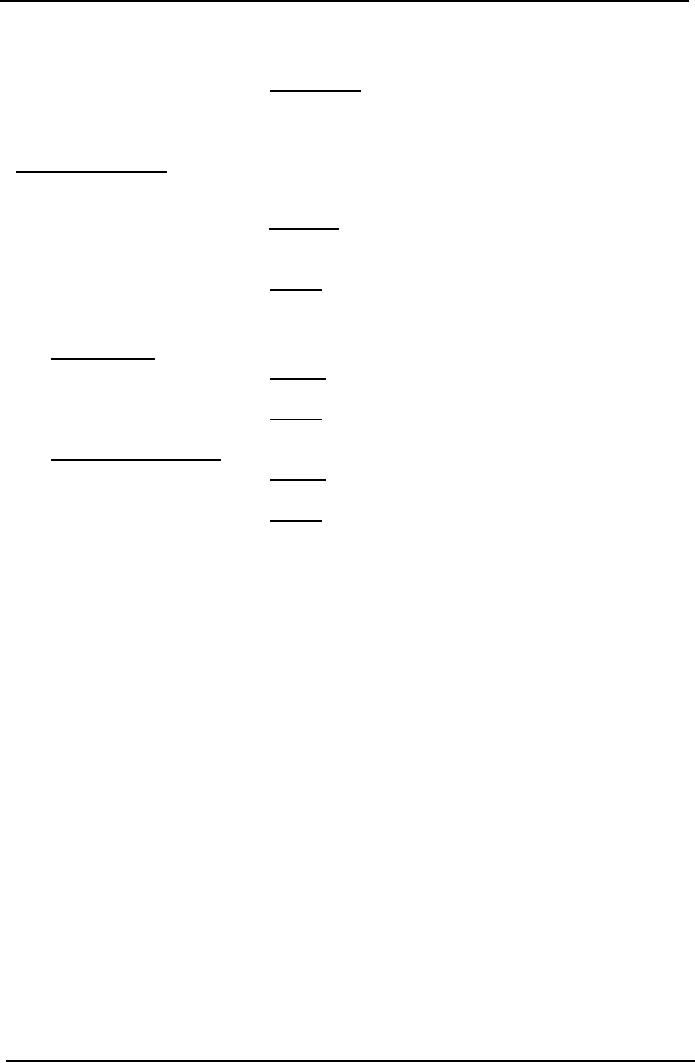
Cost
& Management Accounting
(MGT-402)
VU
Solution:
Average
number of workers
1900
+ 2100 = 2,000
2
1.
Separation Method:
Labor
turnover ratio
80
x 100
=
4%
2,000
Equivalent
annual turnover
4
x 365
=
48.67%
30
2.
Flux Method:
Labor
turnover
80
+ 40 x 100 =
6%
2,000
Equivalent
annual turnover
6
x 365
=
73%
30
3.
Replacement Method:
Labor
turnover
40x
100
=
2%
2,000
Equivalent
annual turnover
2
x 365
=
24.33%
30
The
working results of the above
practice question reveals wide
fluctuations among the
different
annual
labor turnover rates obtained by
different methods of measurement.
The
flux method of labor
turnover denotes the total
change in the composition of
labor force.
While
replacement method takes
into account only workers
appointed against the vacancy
caused
due
to discharge or quitting of the
organisation. This method does
not take into account
the
workers
employed under the expansion schemes of
the company.
However,
it must be noted that if a
department is closed and
workers retrenched, it would not be
a
case
of labor turnover.
The
higher percentage of labor
turnover, the higher will be
the cost of recruitment and
training of
new
workers. A higher rate of labor
turnover also reduces the
efficiency since good deal
of work
would
be done by new inexperienced workers. The
objective of management therefore should
be
to
keep the percentage of labor
turnover at minimal. However, in any
organisation a minimum rate
of
labor turnover will always
occur particularly due to
retirement, marriages, death
and personal
betterment.
Causes
of Labor Turnover
Labor
turnover arises because of various
factors including dissatisfaction
with job, low rate
of
wages,
unsatisfactory working conditions
and non-availability of adequate
basic amenities.
The
causes of labor turnover may
be sub-divided as:
(1)
Avoidable causes, and
(2)
Unavoidable causes.
100

Cost
& Management Accounting
(MGT-402)
VU
(1)
Avoidable Causes:
a)
These include low wages
rate in the present organisation
and the worker may
look
for
higher wages
elsewhere,
b)
Dissatisfaction with job,
c)
Bad working
conditions,
d)
Long and odd working
hours,
e)
Unsatisfactory relationship with
the supervisors,
f)
Bad relationship with the
fellow workers,
g)
Lack of adequate recreational
facilities,
h)
Inadequate housing, medical
facilities,
i)
Unfair methods of promotion and
lack of promotions
avenues,
j)
Lack of planning and
foresight on the part of
management, seasonal nature
of
industry,
non-availability of raw materials,
power, etc.
(2)
Unavoidable Causes include:--
a)
Personal betterment of
worker,
b)
Retirement and death leading
to labor turnover,
c)
Domestic responsibilities--to look
after old parents,
d)
Accident or illness rendering workers
permanently incapable to
work,
e)
Dismissal or discharge due to
insubordination, negligence,
inefficiency, etc.,
f)
Marriages, specially in case of
women workers,
Effect
of Labor Turnover
The
higher rate of labor
turnover results in increased cost of
production. This is due
to--
(i)
Increased
cost of new recruitment,
training,
(ii)
Interruption
of production,
(iii)
Decrease
in production due to inefficiency
and inexperience of
newly
recruited workers,
(iv)
The
new workers are more
accident prone and are
liable to cause
more
damage to machinery, tools
than old employees,
(v)
Losses
due to wastage, spoilage and
defectives,
(vi)
Increased
number of accidents causing
loss of output and
increase
in
medical expenses and cost of
repairs,
(vii)
Lack of cooperation and
coordination between old and
new
employees
resulting fall in output and
increased cost of
production,
LABOR
EFFICIENCY AND UTILISATION
Labor
is a significant cost in many
organisations and it is important to
continually measure
the
efficiency
of labor against pre-set
targets.
Measuring
labor efficiency
To
measure labor efficiency:
Compare actual efficiency
with predetermined targets (or
budgets)
using
`standard hours'.
A
standard hour is the
number of production units
which should be achieved by an
experienced
worker
within a period of one hour.
We
can assume that all
organisations will benefit
from efficient labor, thus
it is important to
measure
how efficient workers are
and identify opportunities
for improvement.
The
following practice question shows
the calculation of the
efficiency ratio.
101
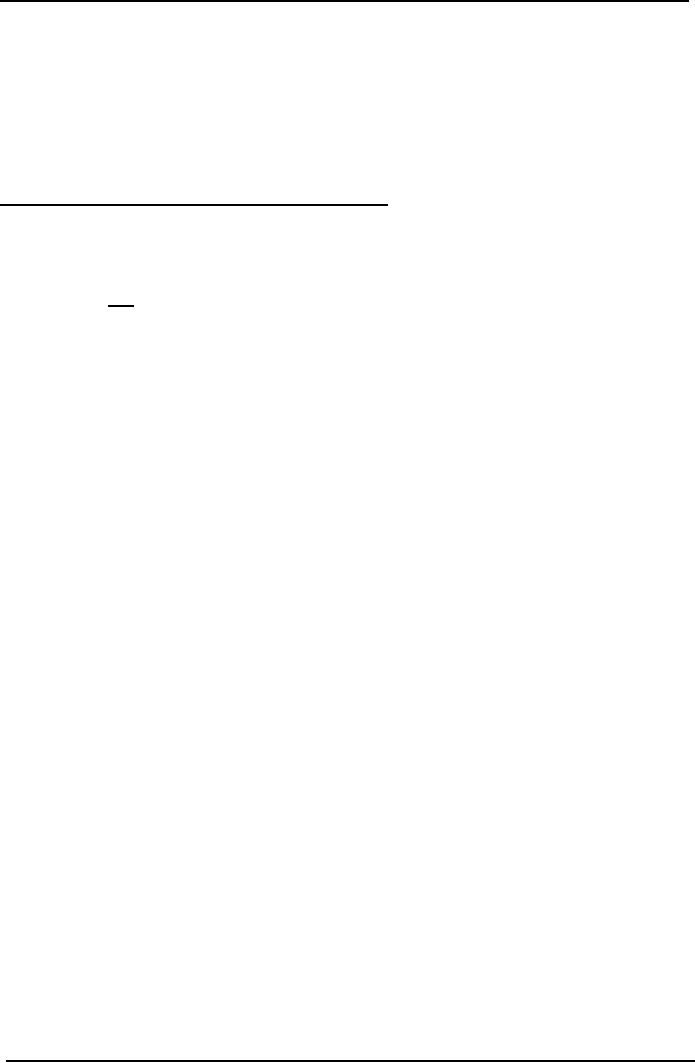
Cost
& Management Accounting
(MGT-402)
VU
PRACTICE
QUESTION
Standard
time allowed per unit
30
minutes
Actual
output in period
840
units
Actual
hours worked
410
Budget
hours worked
400
The
efficiency ratio is calculated by
the following
formula:
Actual
output measured in standard
hours Actual hours
Actual
hours
840
x � hours (30 minutes) = 420
hours
420
x 100 = 102.44%
210
Problem
Question
Calculate
the efficiency ratio from
the following data.
Standard
time allowed per unit
15
minutes
Actual
production
900
units
Actual
hours
250
Budget
hours
200
FACTORY
OVERHEAD COST (FOH)
Factory
overhead costs are those
costs incurred which cannot
be identified directly to cost
unit.
These
are incurred in many
different parts of organisation.
These
include:
1.
Indirect materials
2.
Indirect labor and
3.
Indirect costs attributable to
production and the service
activities associated with
manufacturing.
Marketing,
general administration, research
and development costs that
are not associated
with
manufacturing
are not usually treated as
overheads for this
purpose.
Factory
overhead costs are incurred
in three main
centers:
�
Production
centers
costs
arising in production departments such as
the costs of
fuel,
protective clothing, depreciation
and supervision.
�
Service
centers
the
cost of operating support departments or
sections
within
the factory, for example,
the costs of materials
handling, production control,
and
canteen.
�
General
costs centersgeneral
production overhead such as factory
rent/taxes, heating and
lighting
and production management
salaries.
The
purpose of cost accounting is to provide
information to the management. Management
need
to
know cost per unit as a
basis for valuing inventory
and for decision
making.
FOH
Cost Allocation &
Apportionment
The
total cost of factory
overhead needs to be distributed among
specific cost centers. Some
items
102
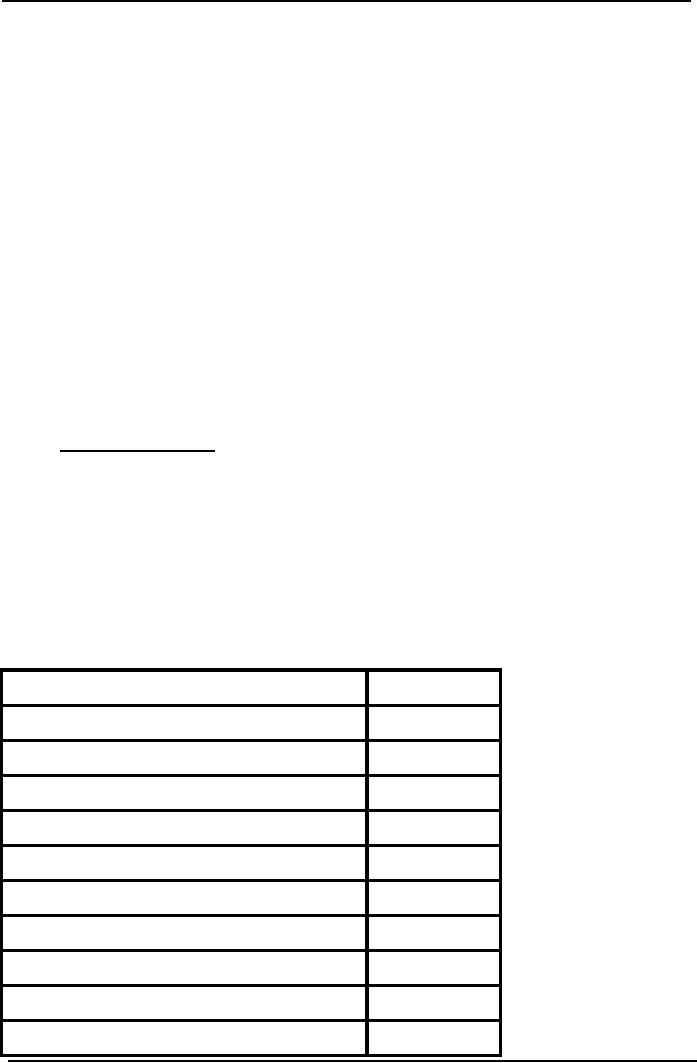
Cost
& Management Accounting
(MGT-402)
VU
can
be allocated immediately, e.g.
the salary of a cost centre supervisor or
indirect materials
issued
to
a cost centre. Other items
need to be apportioned between a
number of centers, e.g.
factory rent
and
taxes or the factory
manager's salary.
Cost
Allocation
It
refers to the costs that
can be identified with
specific cost
centers.
Apportionment
It
refers to the costs that
cannot be identified with
specific cost centre but
must be divided among
the
concerned department/cost centers.
Steps
of Allocation &
Apportionment
1.
Item wise collection of FOH
cost.
2.
Identifying cost centre (Production &
Services).
3.
Allocating and apportioning
general F.O.H cost to the
cost centers.
4.
Apportioning FOH cost of service
cost centers to the
production cost
centers.
5.
Calculation of total FOH cost
for each production cost
centers.
6.
Determining FOH rate for
each production cost
center.
FOH
Absorption Rate
Finally
FOH absorption rate is calculated at
which the cost is absorbed
in the cost unit. This is
also
known
as overhead absorption rate
(OAR) this can be calculated
as under:
OAR
= Estimated F.O.H cost
Base
Bases
for FOH Absorption
Rate
Following
can be used as base to
calculate overhead absorption
rate:
1.
Direct Labor hours
2.
Machine hours
3.
No. of unit produced
4.
Direct labor cost
5.
Prime cost
Problem
Question
Apportion
each of the cost given in four
cost centers A, B, C, and
D
Supervision
Rs.
7,525
Indirect
workers
6,000
Holiday
pay & national
Insurance
6,200
Tolling
cost
9,400
Machine
Maintenance labor cost
4,500
Powers
1,944
Small
tools & Supplies
1,171
Insurance
of machinery
185
Insurance
of building
150
Rent
& rates
2,500
Depreciation
of machinery
9,250
103
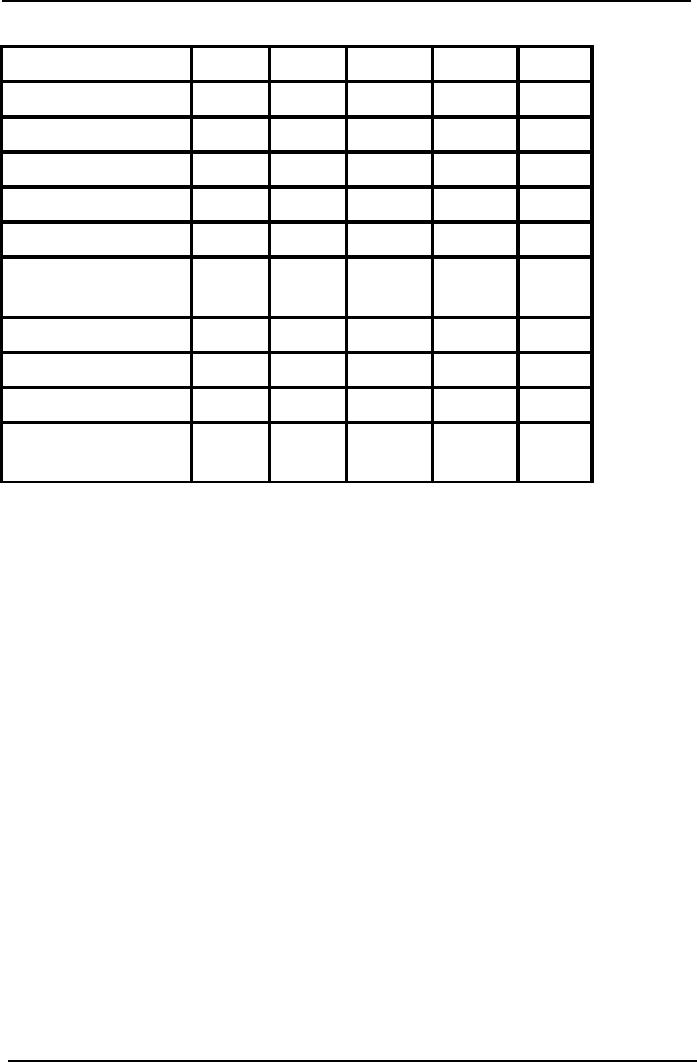
Cost
& Management Accounting
(MGT-402)
VU
Basis
of apportionment of different
costs:
A
B
C
D
Total
1.
Floor Space
1,800
1,500
800
900
5,000
2.
Kilowatt hours
270,000
66,000
85,000
65,000
486,000
3.
Cost of machine
30,000
20,000
8,000
16,000
74,000
4.
Indirect workers
3
3
1
1
8
5.
Total workers
19
24
12
7
62
6.
Machine maintenance
3,000
2,000
3,000
1,000
9,000
hrs
7.
Supervision cost
2,050
2,200
1,775
1,500
7,525
8.
Tooling cost
3,500
4,300
1,000
600
9,400
9.
Small tools &
supplies
491
441
66
173
1,171
10.
Machine running
30,000
36,000
19,000
8,000
93,000
hours
104
Table of Contents:
- COST CLASSIFICATION AND COST BEHAVIOR INTRODUCTION:COST CLASSIFICATION,
- IMPORTANT TERMINOLOGIES:Cost Center, Profit Centre, Differential Cost or Incremental cost
- FINANCIAL STATEMENTS:Inventory, Direct Material Consumed, Total Factory Cost
- FINANCIAL STATEMENTS:Adjustment in the Entire Production, Adjustment in the Income Statement
- PROBLEMS IN PREPARATION OF FINANCIAL STATEMENTS:Gross Profit Margin Rate, Net Profit Ratio
- MORE ABOUT PREPARATION OF FINANCIAL STATEMENTS:Conversion Cost
- MATERIAL:Inventory, Perpetual Inventory System, Weighted Average Method (W.Avg)
- CONTROL OVER MATERIAL:Order Level, Maximum Stock Level, Danger Level
- ECONOMIC ORDERING QUANTITY:EOQ Graph, PROBLEMS
- ACCOUNTING FOR LOSSES:Spoiled output, Accounting treatment, Inventory Turnover Ratio
- LABOR:Direct Labor Cost, Mechanical Methods, MAKING PAYMENTS TO EMPLOYEES
- PAYROLL AND INCENTIVES:Systems of Wages, Premium Plans
- PIECE RATE BASE PREMIUM PLANS:Suitability of Piece Rate System, GROUP BONUS SYSTEMS
- LABOR TURNOVER AND LABOR EFFICIENCY RATIOS & FACTORY OVERHEAD COST
- ALLOCATION AND APPORTIONMENT OF FOH COST
- FACTORY OVERHEAD COST:Marketing, Research and development
- FACTORY OVERHEAD COST:Spending Variance, Capacity/Volume Variance
- JOB ORDER COSTING SYSTEM:Direct Materials, Direct Labor, Factory Overhead
- PROCESS COSTING SYSTEM:Data Collection, Cost of Completed Output
- PROCESS COSTING SYSTEM:Cost of Production Report, Quantity Schedule
- PROCESS COSTING SYSTEM:Normal Loss at the End of Process
- PROCESS COSTING SYSTEM:PRACTICE QUESTION
- PROCESS COSTING SYSTEM:Partially-processed units, Equivalent units
- PROCESS COSTING SYSTEM:Weighted average method, Cost of Production Report
- COSTING/VALUATION OF JOINT AND BY PRODUCTS:Accounting for joint products
- COSTING/VALUATION OF JOINT AND BY PRODUCTS:Problems of common costs
- MARGINAL AND ABSORPTION COSTING:Contribution Margin, Marginal cost per unit
- MARGINAL AND ABSORPTION COSTING:Contribution and profit
- COST – VOLUME – PROFIT ANALYSIS:Contribution Margin Approach & CVP Analysis
- COST – VOLUME – PROFIT ANALYSIS:Target Contribution Margin
- BREAK EVEN ANALYSIS – MARGIN OF SAFETY:Margin of Safety (MOS), Using Budget profit
- BREAKEVEN ANALYSIS – CHARTS AND GRAPHS:Usefulness of charts
- WHAT IS A BUDGET?:Budgetary control, Making a Forecast, Preparing budgets
- Production & Sales Budget:Rolling budget, Sales budget
- Production & Sales Budget:Illustration 1, Production budget
- FLEXIBLE BUDGET:Capacity and volume, Theoretical Capacity
- FLEXIBLE BUDGET:ANALYSIS OF COST BEHAVIOR, Fixed Expenses
- TYPES OF BUDGET:Format of Cash Budget,
- Complex Cash Budget & Flexible Budget:Comparing actual with original budget
- FLEXIBLE & ZERO BASE BUDGETING:Efficiency Ratio, Performance budgeting
- DECISION MAKING IN MANAGEMENT ACCOUNTING:Spare capacity costs, Sunk cost
- DECISION MAKING:Size of fund, Income statement
- DECISION MAKING:Avoidable Costs, Non-Relevant Variable Costs, Absorbed Overhead
- DECISION MAKING CHOICE OF PRODUCT (PRODUCT MIX) DECISIONS
- DECISION MAKING CHOICE OF PRODUCT (PRODUCT MIX) DECISIONS:MAKE OR BUY DECISIONS